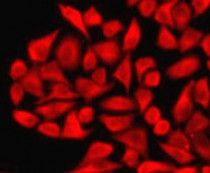ARG59386
anti-UGT1A1 antibody
anti-UGT1A1 antibody for ICC/IF,IHC-Formalin-fixed paraffin-embedded sections,Western blot and Human,Mouse,Rat
Overview
| Product Description | Rabbit Polyclonal antibody recognizes UGT1A1 |
|---|---|
| Tested Reactivity | Hu, Ms, Rat |
| Tested Application | ICC/IF, IHC-P, WB |
| Host | Rabbit |
| Clonality | Polyclonal |
| Isotype | IgG |
| Target Name | UGT1A1 |
| Antigen Species | Human |
| Immunogen | Recombinant fusion protein corresponding to aa. 1-200 of Human UGT1A1 (NP_000454.1). |
| Conjugation | Un-conjugated |
| Alternate Names | EC 2.4.1.17; UGT1; HUG-BR1; Bilirubin-specific UDPGT isozyme 1; UGT1A; BILIQTL1; UDP-glucuronosyltransferase 1-A; UDP-glucuronosyltransferase 1A1; hUG-BR1; UGT1-01; UDPGT 1-1; UGT-1A; UGT1*1; UGT1.1; GNT1; UDPGT; UDP-glucuronosyltransferase 1-1 |
Application Instructions
| Application Suggestion |
|
||||||||
|---|---|---|---|---|---|---|---|---|---|
| Application Note | * The dilutions indicate recommended starting dilutions and the optimal dilutions or concentrations should be determined by the scientist. | ||||||||
| Positive Control | HepG2 | ||||||||
| Observed Size | ~ 66 kDa |
Properties
| Form | Liquid |
|---|---|
| Purification | Affinity purified. |
| Buffer | PBS (pH 7.3), 0.02% Sodium azide and 50% Glycerol. |
| Preservative | 0.02% Sodium azide |
| Stabilizer | 50% Glycerol |
| Storage Instruction | For continuous use, store undiluted antibody at 2-8°C for up to a week. For long-term storage, aliquot and store at -20°C. Storage in frost free freezers is not recommended. Avoid repeated freeze/thaw cycles. Suggest spin the vial prior to opening. The antibody solution should be gently mixed before use. |
| Note | For laboratory research only, not for drug, diagnostic or other use. |
Bioinformation
| Database Links | |
|---|---|
| Gene Symbol | UGT1A1 |
| Gene Full Name | UDP glucuronosyltransferase 1 family, polypeptide A1 |
| Background | This gene encodes a UDP-glucuronosyltransferase, an enzyme of the glucuronidation pathway that transforms small lipophilic molecules, such as steroids, bilirubin, hormones, and drugs, into water-soluble, excretable metabolites. This gene is part of a complex locus that encodes several UDP-glucuronosyltransferases. The locus includes thirteen unique alternate first exons followed by four common exons. Four of the alternate first exons are considered pseudogenes. Each of the remaining nine 5' exons may be spliced to the four common exons, resulting in nine proteins with different N-termini and identical C-termini. Each first exon encodes the substrate binding site, and is regulated by its own promoter. The preferred substrate of this enzyme is bilirubin, although it also has moderate activity with simple phenols, flavones, and C18 steroids. Mutations in this gene result in Crigler-Najjar syndromes types I and II and in Gilbert syndrome. [provided by RefSeq, Jul 2008] |
| Function | UDPGT is of major importance in the conjugation and subsequent elimination of potentially toxic xenobiotics and endogenous compounds. This isoform glucuronidates bilirubin IX-alpha to form both the IX-alpha-C8 and IX-alpha-C12 monoconjugates and diconjugate. Is also able to catalyze the glucuronidation of 17beta-estradiol, 17alpha-ethinylestradiol, 1-hydroxypyrene, 4-methylumbelliferone, 1-naphthol, paranitrophenol, scopoletin, and umbelliferone. Isoform 2 lacks transferase activity but acts as a negative regulator of isoform 1. [UniProt] |
| Cellular Localization | Isoform 1: Microsome. Endoplasmic reticulum membrane; Single-pass membrane protein. Isoform 2: Microsome. Endoplasmic reticulum. [UniProt] |
| Calculated MW | 60 kDa |
Images (2) Click the Picture to Zoom In







